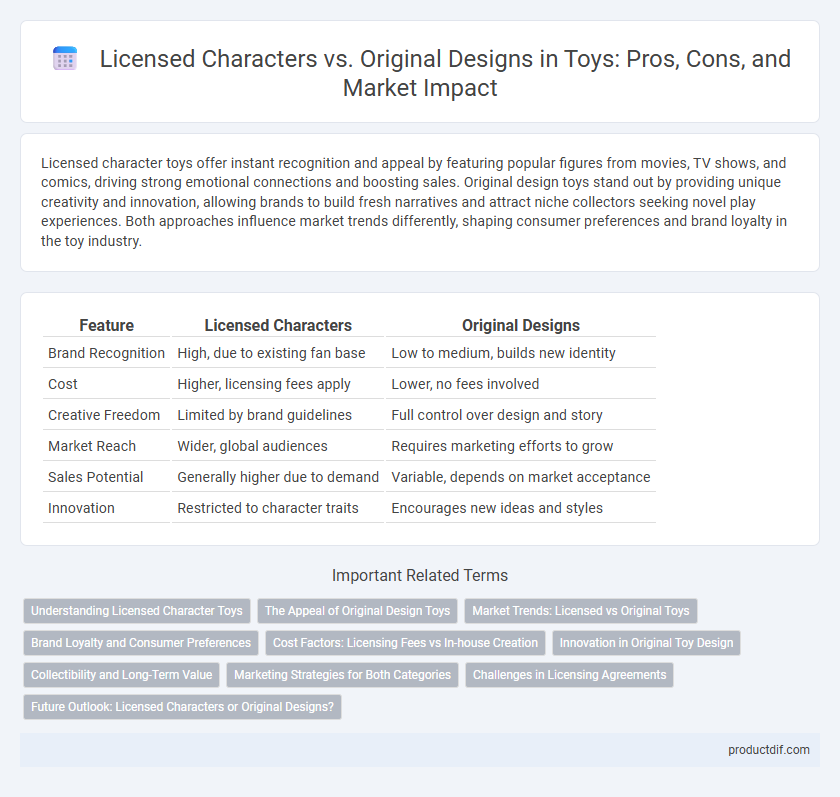Licensed character toys offer instant recognition and appeal by featuring popular figures from movies, TV shows, and comics, driving strong emotional connections and boosting sales. Original design toys stand out by providing unique creativity and innovation, allowing brands to build fresh narratives and attract niche collectors seeking novel play experiences. Both approaches influence market trends differently, shaping consumer preferences and brand loyalty in the toy industry.
Table of Comparison
| Feature | Licensed Characters | Original Designs |
|---|---|---|
| Brand Recognition | High, due to existing fan base | Low to medium, builds new identity |
| Cost | Higher, licensing fees apply | Lower, no fees involved |
| Creative Freedom | Limited by brand guidelines | Full control over design and story |
| Market Reach | Wider, global audiences | Requires marketing efforts to grow |
| Sales Potential | Generally higher due to demand | Variable, depends on market acceptance |
| Innovation | Restricted to character traits | Encourages new ideas and styles |
Understanding Licensed Character Toys
Licensed character toys leverage popular franchises such as Disney, Marvel, and Star Wars to attract dedicated fan bases and boost sales through established brand recognition. These toys often feature high-quality craftsmanship and detailed likenesses that appeal to collectors and children alike, ensuring authenticity and emotional connection. Original design toys offer creative freedom and unique storytelling opportunities but typically rely on innovative marketing to build brand loyalty from scratch.
The Appeal of Original Design Toys
Original design toys captivate collectors and children alike by offering unique characters that spark imagination and creativity, distinguishing them from mass-produced licensed characters. These toys often feature innovative aesthetics and storytelling potential, fostering a deeper emotional connection with users. The appeal lies in their exclusivity and artistic expression, making original designs highly sought after within niche markets and among enthusiasts.
Market Trends: Licensed vs Original Toys
Market trends reveal that licensed toys based on popular characters consistently generate higher initial sales due to established fan bases and media exposure. Original toy designs, however, show growing market potential by appealing to collectors and niche audiences seeking unique and innovative play experiences. Retailers increasingly balance inventory to capture both mainstream popularity and exclusive appeal in the evolving toy industry landscape.
Brand Loyalty and Consumer Preferences
Licensed characters in toys generally generate stronger brand loyalty due to existing emotional connections and established fan bases, leading to higher consumer preference and repeat purchases. Original designs appeal to niche markets seeking uniqueness and creativity, but often require extensive marketing to build comparable trust and recognition. Sales data consistently show licensed character toys outperform original designs in mainstream markets because of their immediate brand value and consumer familiarity.
Cost Factors: Licensing Fees vs In-house Creation
Licensing fees for toys featuring licensed characters typically range from 10% to 20% of net sales, significantly increasing production costs compared to original designs developed in-house. Original toy designs avoid these fees but incur higher upfront expenses in concept development, prototyping, and marketing to build brand recognition. Balancing licensing costs with market appeal is crucial for manufacturers aiming to maximize profitability while maintaining consumer interest.
Innovation in Original Toy Design
Original toy designs drive innovation by introducing unique characters and creative concepts that differentiate products in a crowded market. Unlike licensed characters, which rely on established franchises, original toys benefit from greater artistic freedom, enabling fresh storytelling and novel play experiences. This innovation fosters brand identity and can lead to new trends in the toy industry.
Collectibility and Long-Term Value
Licensed character toys often command higher collectibility and long-term value due to established fan bases and recognizable intellectual properties like Marvel or Star Wars. Original designs can achieve niche market appeal and unique artistic value but generally carry higher risk for sustained demand and appreciation. Investing in licensed toys typically offers more stable resale potential, while original designs might yield higher rewards if they gain cult status.
Marketing Strategies for Both Categories
Marketing strategies for licensed character toys leverage established brand recognition and fan loyalty, often utilizing cross-promotions with media franchises to maximize visibility and sales. Original design toys emphasize innovation and uniqueness, targeting niche markets through storytelling, limited editions, and community engagement to build a dedicated customer base. Both approaches utilize targeted digital advertising and social media influencers to enhance consumer connection and drive product demand.
Challenges in Licensing Agreements
Licensing agreements for toys featuring licensed characters often involve complex negotiations around royalty rates, territorial restrictions, and creative control, which can delay production timelines. Manufacturers must navigate stringent approval processes imposed by intellectual property holders, limiting flexibility in design modifications and marketing strategies. Compliance with these contractual obligations increases costs and impacts the ability to rapidly respond to market trends compared to original toy designs.
Future Outlook: Licensed Characters or Original Designs?
Licensed characters continue to dominate the toy industry due to strong brand recognition and existing fan bases, driving consistent sales and market demand. Original designs are gaining traction as manufacturers seek innovation and the ability to control intellectual property, leading to unique product lines and higher profit margins. The future outlook suggests a balanced approach where licensed characters ensure stable revenue while original designs provide opportunities for growth and brand differentiation.
Licensed characters vs original designs Infographic

 productdif.com
productdif.com